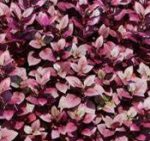 Grown primarily for its foliage, this tender evergreen herbaceous perennial is native to the West Indies and Brazil and is a member of the amaranth family, Amaranthaceae, that also includes beets, spinach, celosia, and gomphrena. Plants are sprawling to upright and grow 1-3′ tall. They have linear to lanceolate leaves 3-4″ long and with pointed tips. The leaves of the species have dark green tops and paler undersides while those of the popular cultivars are purple to burgundy. From fall into winter small spikes of inconspicuous white to greenish apetalous flowers are produced in the leaf axils. A popular edger, this plant also does well in containers and can be brought indoors during the winter if it is provided with bright light and consistently moist well-drained soil. The genus name, Alternanthera, comes from the Latin word alternus meaning alternating and the Greek word anthos meaning flower but later used to refer to the pollen bearing part of the flower. The term refers to the arrangement of the anthers in the flowers. The specific epithet, dentata, comes from the Latin word dens meaning tooth and refers to the toothed margins of the leaves.
Grown primarily for its foliage, this tender evergreen herbaceous perennial is native to the West Indies and Brazil and is a member of the amaranth family, Amaranthaceae, that also includes beets, spinach, celosia, and gomphrena. Plants are sprawling to upright and grow 1-3′ tall. They have linear to lanceolate leaves 3-4″ long and with pointed tips. The leaves of the species have dark green tops and paler undersides while those of the popular cultivars are purple to burgundy. From fall into winter small spikes of inconspicuous white to greenish apetalous flowers are produced in the leaf axils. A popular edger, this plant also does well in containers and can be brought indoors during the winter if it is provided with bright light and consistently moist well-drained soil. The genus name, Alternanthera, comes from the Latin word alternus meaning alternating and the Greek word anthos meaning flower but later used to refer to the pollen bearing part of the flower. The term refers to the arrangement of the anthers in the flowers. The specific epithet, dentata, comes from the Latin word dens meaning tooth and refers to the toothed margins of the leaves.
Type: Tender evergreen herbaceous perennial
Bloom: Small spikes of white to greenish apetalous flowers from fall to winter
Size: 1-2′ H x 1-2’W
Light:Full sun to part shade
Soil: Organically rich, consistently moist, well-drained
Hardiness: Zones 10-11 as perennial
Care:Pinch to encourage bushiness
Pests and Diseases: None of significance
Propagation: Seed, stem cutting (root easily in water)
Companion Plants: Lantana, begonia, liriope, red annual salvia
Outstanding Selections:
‘Little Ruby’ (purple leaves)
‘Wave hill’ (large plant with large purple leaves)